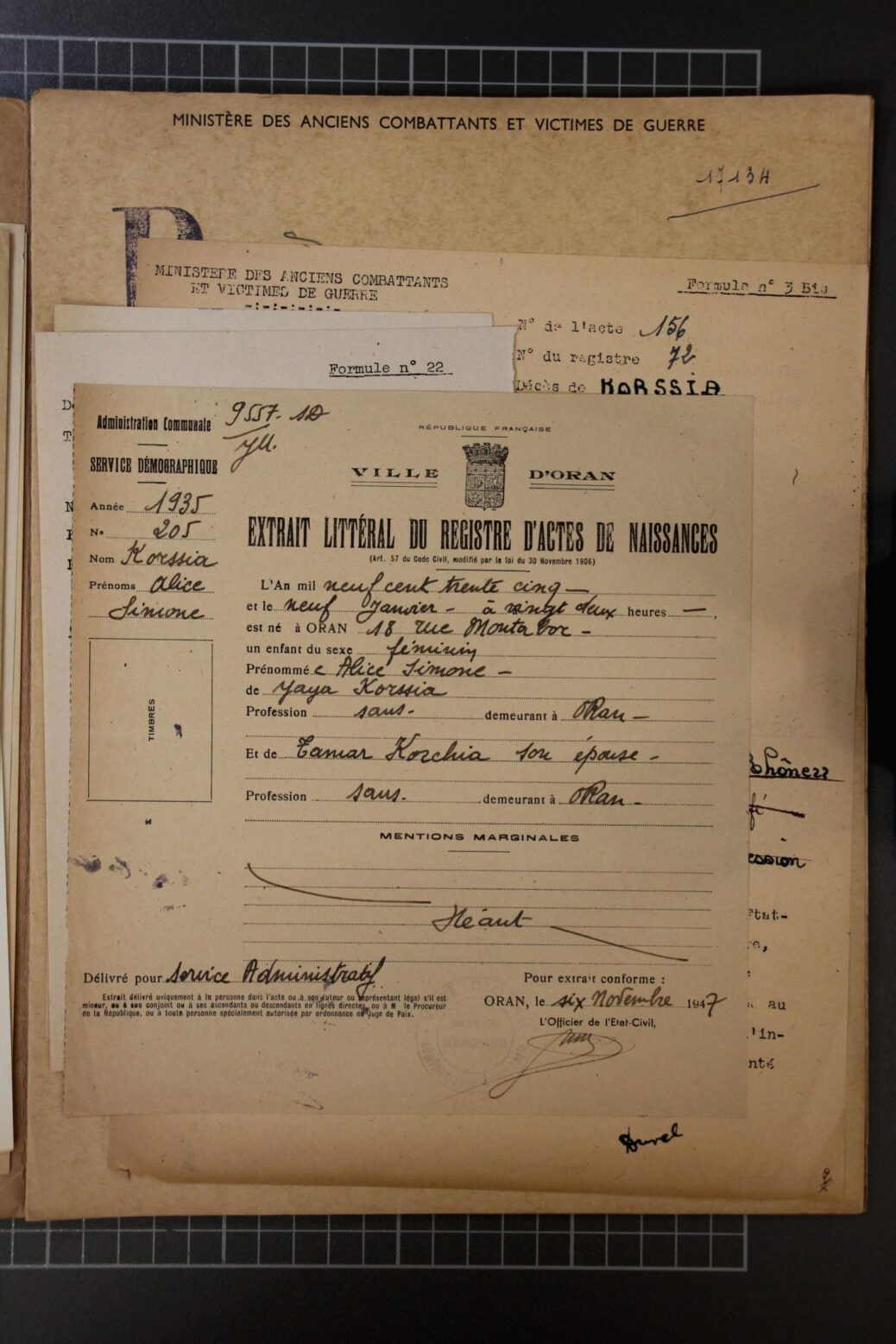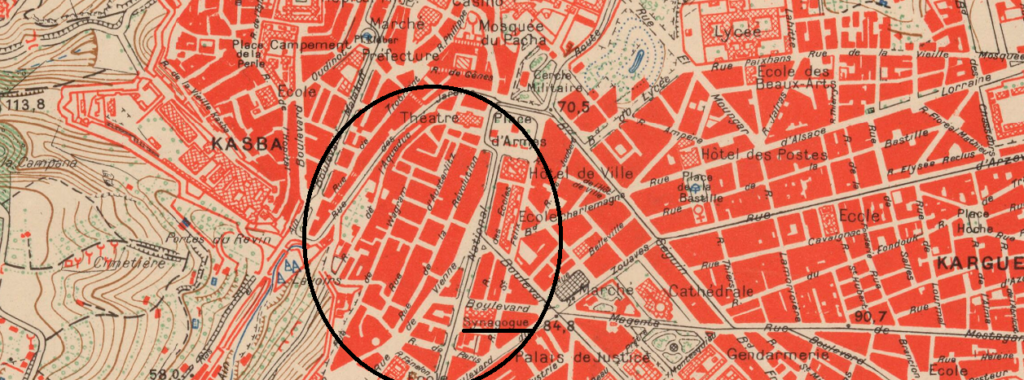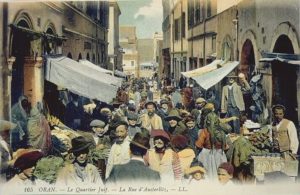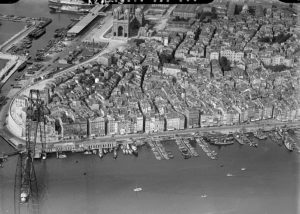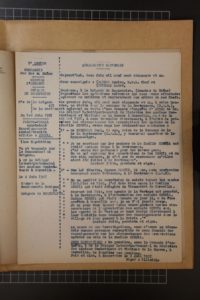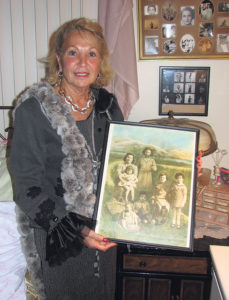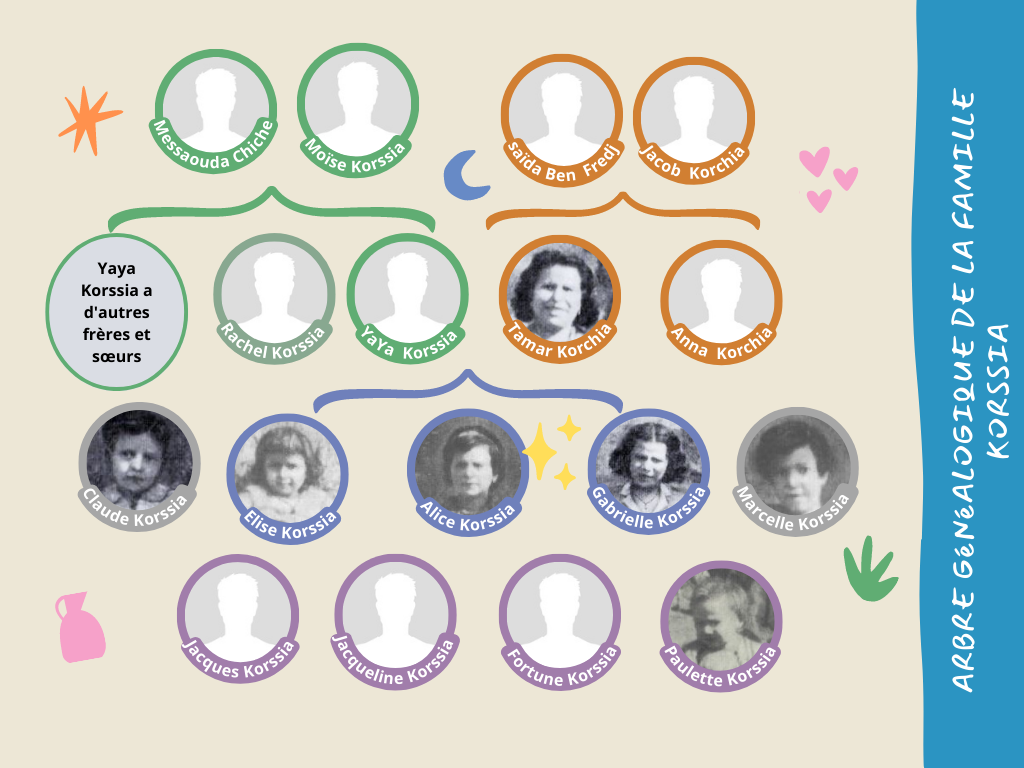Alice KORSSIA
Alice Korssia’s birth certificate. Source: SHD (the French Defense Historical Service)
Alice’s birth and childhood in Oran, Algeria (1935-1939)
According to her birth certificate, Alice Korssia was born at 18 rue Montabor in Oran, Algeria, at 10 pm on January 9, 1935. Her father was called Yaya and her mother was Tamar. When she was born, they were 33 and 31 years old respectively. She was their fifth child. They already had Fortune, Jacques, Jacqueline and Gabrielle while Marcelle, Élise, Claude and Paulette were yet to come.
Rue Montabor was in the Jewish quarter of Oran, to the west of the city center. The streets in the neighborhood were named after Napoleon’s victories.
The Jewish quarter of Oran, BNF
In those days, it was a lively and densely populated area. In 1936, Oran had a population of 205,000, of whom around 2,500 lived in this neighborhood. The district is now very run down, with the exception of the synagogue, which has been converted into a mosque.
Rue d’Austerlitz, MAHJ
Algerian Jews had become French citizens when the Crémieux decree was passed in 1870. After Claude was born, the Korssia family, who were very poor, left Algeria for Marseille, on the south coast of France, where Alice’s father hoped to find work. They travelled there by boat.
Her life in Marseille (1939-1942)
The port of Marseille, with its lifting bridge, 1940 © ign 1932
The Korssia family lived on Quai du Maréchal Pétain in the Saint Jean district of Marseille, on the northern side of the Old Port. It was a poor neighborhood that was home to a large number of foreigners (Greeks, Italians, Spaniards etc.) and an area where prostitutes plied their trade. There were 20,000 people living in the neighborhood, which was in an old part of town, with dilapidated buildings and very narrow streets. In November 1942, the Allies landed in North Africa. The Germans then decided to occupy Marseille, even though it was located in what was known as the “free zone”, in the southern part of France.
In January 1943, the French police and German soldiers stopped everyone in the neighborhood and checked their identity documents. Many people were interned. This was known as Operation Sultan. In February 1943, the neighborhood was completely evacuated; the apartment blocks were blown up with dynamite. By that time, the Korssia family appears to have left Marseille and moved to La Destrousse. However, Alice’s father, who was still working in Marseille, was arrested and interned in Drancy camp, from where he was deported to the Sobibor extermination camp on March 23, 1943.
Alice’s arrest in La Destrousse in May 1944
Investigation into the arrest of the Korssia family
Little is known about the arrests of the other members of the Korssia family. Paulette recalls that in May 1944 her mother Tamar took her to the hospital in Marseille, where Tamar was arrested but Paulette was saved by a nurse who passed her off as her daughter. The Gestapo then went to La Destrousse to look for the rest of the family. Ginette Martin, a secretary at the town hall, kept Jacques hidden, but Alice, Marcelle, Claude and Élise were arrested. They were first taken to the Baumettes prison in Marseille and then transferred to Drancy camp.
Internment in Drancy, from July 19 – 31, 1944
On July 19, 1944, Alice arrived in Drancy camp, which was located north-east of Paris in the Seine-Saint-Denis department of France. Before it was converted into a camp, Drancy was known as the Cité de La Muette, a housing estate with 1,250 low-cost apartments. In 1940, the Germans requisitioned the site to house French and British prisoners of war and then in August 1941, it became an internment camp for Jews.
The living conditions there were awful. It was unhygienic, the food was poor and disease was rife. During the war, 63,000 Jews were interned there. In 1946, the barbed wire that surrounded the camp was removed, as were the watchtowers, and the accommodation in the “U-shaped” building was converted into housing. Some 500 people still live there today. The site was listed as a historic monument in 2001.
Deportation to the Auschwitz killing center
Alice was deported on Convoy 77, which left Drancy on July 31, 1944. It was a freight train, bound for Auschwitz. It arrived on August 3, 1944 after a three-day journey. Alice traveled in appalling conditions. The people were treated like cattle and the Nazis tried to dehumanize them. 1,306 people were deported on Convoy77, 324 of whom were under 16. 847 of them were exterminated as soon as they arrived at Auschwitz. This is what happened to Alice, her mother, her three sisters and her brother. Their names are all listed on the Wall of Names at the entrance to the Shoah Memorial in Paris.
Photograph of the Korssia family
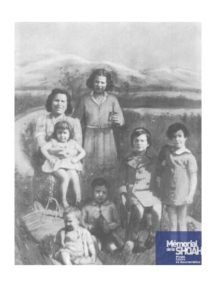 Photograph of the Korssia family including Alice, 2nd from the right, sitting.
Photograph of the Korssia family including Alice, 2nd from the right, sitting.
Source: Serge Klarsfeld collection
We found this photograph in the Children’s Memorial section of the Shoah Memorial website. It was probably taken at La Destrousse. Alice’s mother, Tamar, is seated with Élise, who was born in Marseille on December 14, 1940, on her lap. The toddler at her feet is Paulette.The girl beside her is Gabrielle, who was born in Marseille. The little boy sitting on the floor in the center is Claude, who was born on April 25, 1939 in Oran. The little girl standing on the right is Marcelle, who was born in August 1936 in Oran. Alice is sitting beside her.
Paulette Korssia
Paulette Dorflaufer, Alice’s younger sister
While researching Alice, we found out that Paulette, Alice’s younger sister, is still alive. During the war, she was hidden by a nurse, and thus avoided being deported and survived. After the war, she was adopted by an American family. She now lives in Livingstone in the United States. Ms Novoa contacted her on Facebook. She is delighted that we are researching Alice’s story. In order to help us, she kindly sent us a notebook in which she has listed some details about her family.
Alice Korssia’s family tree
Sandy produced this Korssia family tree.
Alice’s family tree, produced by Sandy
As part of an e-Twinning project, we worked with some high school students from Gniezno on translating Alice’s biography into English and Polish. Here is the biography in Polish, written and illustrated by Julia, Marianna, Weronika, Julia, Paulina, Weronika, Tamara, Malwina, Tosia, Maja, Jagoda, Oliwia, Sebastian et Jan les élèves de Jagoda Grobelna.
Sources:
- Defense Historical Service, ref. AC 21 P 470104, Individual file on KORSSIA, ALICE, SIMONE
- Serge Klarsfeld collection
Links:
- https://ressources.memorialdelashoah.org/notice.php?q=identifiant_origine:(FRMEMSH0408707106935)
- https://gallica.bnf.fr/ark:/12148/btv1b530651971/f1.item.zoom
- https://www.mahj.org/fr/decouvrir-collections-betsalel/oran-le-quartier-juif-la-rue-dausterlitz-8773
- https://www.marseille.fr/sites/default/files/contenu/mairie/RAFLES-1943/livret_commemorations_rafles_1943.pdf
- https://www.marseille.fr/mairie/les-vieux-quartiers-dans-les-annees-40
- https://drancy.memorialdelashoah.org/le-memorial-de-drancy/qui-sommes-nous/histoire-de-la-cite-de-la-muette.html
- https://njjewishnews.timesofisrael.com/shoa-orphan-rediscovers-her-lost-siblings/


 Français
Français Polski
Polski